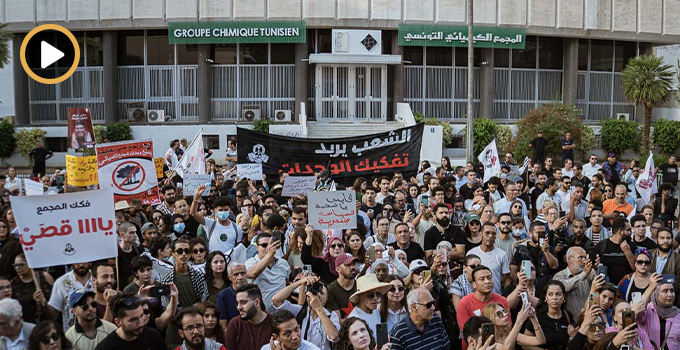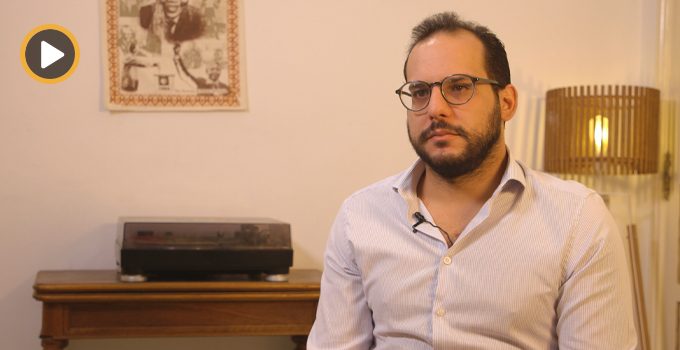
“What happened today is nothing but the start of a series of protests that will not only be regional but national,” Basma Lajmi, an Ezzahra resident, environmental activist and one of the organizers of the demonstration told Meshkal/Nawaat.
Lajmi is one of the moderators of the Facebook group “Shut Down ONAS on the Southern Suburbs’ Sea”. ONAS is the french acronym of the National Sanitation Utility, which manages wastewater. They were also supported by the Tunisian Forum for Economic and Social Rights (FTDES).
“I remember 25 years ago in the 1990s while swimming here, we used to see weird looking white bubbles around us. And when we grew up we figured that they were the result of chemical products. It all started gradually” added Lajmi.

Approximately 70,000 cubic meters of sewage is dumped daily through pipes into rivers that lead directly to the seashore, Taoufik El Bahrouni, an official at the State’s National Environmental Protection Agency (ANPE) told National Radio. Those rivers are the Oued Khmis river, between Ezzahra and Bougarnine, the Oued Miizet between Ezzahra and Rades, and the Oued Melyen that starts from Bargou Town in Siliana governorate and crosses different regions before reaching Rades.
Because of the malfunctioning of some ONAS sewage treatment centers like the Attar station in the densely populated neighborhood of Sijoumi, sewage and wastewater from there ends up on the southern coastal suburbs. But repairs are costly and will take time, officials say.
“In a meeting with ONAS communication team, we were informed that repairs cannot be started because they don’t have the budget for it; however, their CEO said the opposite,” said Doniazed Tounsi, President of Citizen Action Ezzahra, an association active in local public affairs like beach and sea management, encouraging residents to be more socially active, and being a watchdog on municipal government issues.
Tounsi is also another moderator of the Facebook group Shut Down ONAS on the Southern Suburbs’ Sea. The meeting between civil society and ONAS occurred on August the 31st 2021 in the Hammam Lif municipality, and included Citizen Action Ezzahra and other environmental activists who are residents of the Southern suburbs, according to Tounsi. Video of part of that meeting was posted online.

The head of Regional Sanitation Directorate for Greater Tunis Ali Jmaiel told National Radio in an interview on September 9 that authorities are “searching for support” financially to make infrastructure fixes to stop the pollution, which cost 250 million dinars by his estimation. But he said that civic groups they’ve met with aren’t understanding about funding and time challenges.
“When we had a meeting with them and explained to them this situation, probably they didn’t accept that this is a project of four, five or even ten years,” Jemail said in the interview.
Health Issues
Wastewater is an issue because it has affected the health of beachgoers, especially their skin–predominantly skin fungus and rashes, according to Ezzahra residents.
“As a kid, it took me years to heal from the rashes I suffered from because of the beach,” Lajmi told Meshkal/Nawaat.
Residents of the area also complained about the nauseous smell that pushed them away from enjoying the beach and they are still living in fear of another ecological catastrophe like the 2015 mass fish death on the Rades shores.

Lajmi and other demonstrators primarily blame ONAS, the State public utility directly responsible for sewage and wastewater management for dumping the waste into the sea. However they also blame other State institutions for the pollution especially since only 86 percent of the population in all of Ben Arous governorate, including Ezzahra, are connected to ONAS’ water purification system. That’s according to ONAS’s own numbers from 2018, showing only 601,000 people out of 698,000 in the whole region are connected, with many living in informal housing unconnected to the existing infrastructure. Lajmi told Meshkal/Nawaat that people living in informal housing structures dump their waste directly into the rivers.
“We as citizens are aware of their failure to honor their environmental responsibilities and ONAS is not the only institution we put blame on,” Lajmi told Meshkal/Nawaat.
“The ANPE, APAL, Health Ministry, Ministry of Agriculture and Fisheries and the Ministry of Environment also failed to live up to their missions,” Lajmi said, referring to the National Environmental Protection Agency (ANPE) and the Coastal Protection and Planning Agency (APAL) which are both under the Ministry of Environment.

Meshkal/Nawaat went to the Ministry of Environment’s ONAS central office in Tunis and spoke with a spokesperson to get a more detailed response, but an ONAS spokesperson said they were not authorized to give comment without approval from ONAS’ CEO. Meshkal/Nawaat did not yet receive a reply as this article went to publication.
Quality of Life Issues
Aside from affecting their health, the sewage is also affecting residents quality of life, as Slim Mouelhi Ezzahra resident and administrator of the Facebook group “Sauvez notre plage Sauvez notre Banlieue Sud” [Save our Beach, Save our Southern Suburb] said.
“Fighting this Environmental terrorism is a necessity as it not only affects nature but directly devastates the commercial and tourism movements of the area. The responsible institutions must be held accountable,” Mouelhi told Meshkal/Nawaat. Around five different volunteer organizations who helpedorganize the massive protest on September 12.

“It is our responsibility to preserve the beach for the coming generations. Uniting our powers will lead us to change,” Arbi Jaouen, a 24 year old scout and Ezzahra resident at the September demonstration told Meshkal/Nawaat.
Organizers estimated that around 3000 citizens from different regions participated in the coordinated demonstrations demanding the immediate end to the pollution of their coastline that threatens not only the ecological system but also human life. Meshkal/Nawaat observed about 700 citizens in the Ezzahra section of the demonstrations alone.
This article was produced as part of a reporting partnership between Meshkal and Nawaat.




iThere are no comments
Add yours